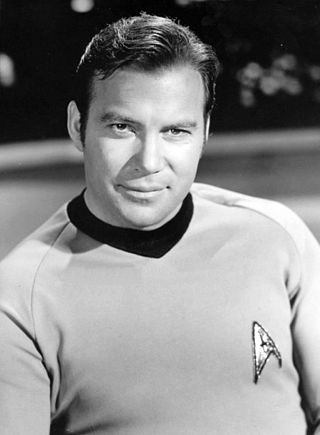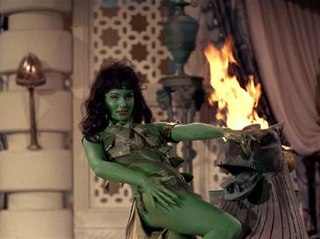Related Research Articles

Eugene Wesley Roddenberry Sr. was an American television screenwriter and producer who created the science fiction franchise Star Trek. Born in El Paso, Texas, Roddenberry grew up in Los Angeles, where his father was a police officer. Roddenberry flew 89 combat missions in the Army Air Forces during World War II and worked as a commercial pilot after the war. Later, he joined the Los Angeles Police Department and began to write for television.

Star Trek: The Animated Series (TAS) is an American animated science fiction television series created by Gene Roddenberry. It originally aired simply under the title Star Trek, subtitled Created by Gene Roddenberry, on Saturday mornings from September 8, 1973 to October 12, 1974 on NBC, spanning 22 episodes over two seasons. The second series in the Star Trek franchise, it features mostly the same characters as Star Trek: The Original Series. Set in the 23rd century, the series follows the further adventures of the Starship USS Enterprise as it explores the galaxy.

James Tiberius Kirk, commonly known as James T. Kirk or Captain Kirk, is a fictional character in the Star Trek media franchise. Originally played by Canadian actor William Shatner, Kirk first appeared in Star Trek serving aboard the starship USS Enterprise as captain. Kirk leads his crew as they explore new worlds, new civilizations, and "boldly go where no man has gone before". Often, the characters of Spock and Leonard "Bones" McCoy act as his logical and emotional sounding boards, respectively. Kirk has also been portrayed in numerous films, books, comics, webisodes, and video games.

Spock is a fictional character in the Star Trek media franchise. He first appeared in the original Star Trek series serving aboard the starship USS Enterprise as science officer and first officer and later as commanding officer of the vessel. Spock's mixed human–Vulcan heritage serves as an important plot element in many of the character's appearances. Along with Captain James T. Kirk and Dr. Leonard "Bones" McCoy, he is one of the three central characters in the original Star Trek series and its films. After retiring from active duty in Starfleet, Spock served as a Federation ambassador, and later became involved in the ill-fated attempt to save Romulus from a supernova, leading him to live out the rest of his life in a parallel universe.

Majel Barrett-Roddenberry was an American actress. She was best known for her roles as various characters in the Star Trek franchise: Nurse Christine Chapel, Number One, Lwaxana Troi, and the voice of most onboard computer interfaces throughout the series from 1966 to 2023. She married Star Trek creator Gene Roddenberry in 1969. As his wife and given her relationship with Star Trek—participating in some way in every series during her lifetime—she is sometimes referred to as "the First Lady of Star Trek".

Star Trek: Phase II was the initial working title for what officially became titled Star Trek II, an unproduced American science fiction television series created by Gene Roddenberry as a sequel to the original Star Trek, which had run from 1966 to 1969. The plans for the series were first developed after several failed attempts to create a feature film based on the property, coupled with plans for a Paramount Television Service (PTS) as a fourth broadcast television network in the United States.

Christopher Pike is a fictional character in the Star Trek science fiction franchise. He is the immediate predecessor to James T. Kirk as captain of the starship USS Enterprise.

Hikaru Kato Sulu is a fictional character in the Star Trek media franchise. A member of the crew in the original Star Trek series, Sulu also appears in the animated Star Trek series, in the first six Star Trek movies, in one episode of Star Trek: Voyager, and in several books, comics, and video games. Originally known simply as "Sulu", his first name, "Hikaru", appeared in a 1981 novel well over a decade after the original series had ended.
"The Cage" is the first pilot episode of the American television series Star Trek. It was completed on January 22, 1965. The episode was written by Gene Roddenberry and directed by Robert Butler. It was rejected by NBC in February 1965, and the network ordered another pilot episode, which became "Where No Man Has Gone Before". Much of the original footage from "The Cage" was later incorporated into the season 1 two-part episode "The Menagerie" (1966); however, "The Cage" was first released to the public on VHS in 1986, with a special introduction by Gene Roddenberry, as a hybrid of the color footage that was used in "The Menagerie" and black and white footage which was not used in "The Menagerie". It was not broadcast on television in its complete all-color form until 1988. The black and white version and all-color version were also released in various standard-definition media including LaserDisc, VHS, and DVD formats.
"Encounter at Farpoint" is the pilot episode and series premiere of the American science fiction television series Star Trek: The Next Generation, which premiered in syndication on September 28, 1987. It was written by D. C. Fontana and Gene Roddenberry and directed by Corey Allen. Roddenberry was the creator of Star Trek, and Fontana was a writer on the original series. It was originally aired as a two-hour TV movie, and subsequent reruns typically split the episode into two parts.

"Where No Man Has Gone Before" is the third episode of the first season of the American science-fiction television series Star Trek. Written by Samuel A. Peeples and directed by James Goldstone, it first aired on September 22, 1966.

Christine Chapel is a fictional character who appears in all three seasons of the American science fiction television series Star Trek: The Original Series, as well as Star Trek: The Animated Series and the films Star Trek: The Motion Picture and Star Trek IV: The Voyage Home. Portrayed by Majel Barrett, she was the ship's nurse on board the Starfleet starship USS Enterprise. A younger version of Chapel appears in the 2022 series Star Trek: Strange New Worlds, portrayed by Jess Bush.

Janice Rand is a fictional character in the American science fiction television series Star Trek: The Original Series during its first season, as well as three of the Star Trek films. She is the Captain's yeoman on board the USS Enterprise (NCC-1701), and first appeared in the episode "The Man Trap". She had significant roles in the episodes "The Enemy Within", where she fights off an evil version of Captain James T. Kirk; "Charlie X" where a young man with god-like powers falls in love with her; and "Miri" where she is infected with a deadly disease while on an away mission and is kidnapped by jealous children.

Una Chin-Riley, commonly and originally only known as Number One, is a fictional character in the science-fiction franchise Star Trek. She is Christopher Pike's second-in-command during his captaincy of the starship Enterprise.
"The Infinite Vulcan" is the seventh episode of the first season of the American animated science fiction television series Star Trek: The Animated Series. It first aired on NBC on October 20, 1973, and was written by Original Series cast member Walter Koenig. It was the actor's only involvement in the series, as he had not been hired to voice Pavel Chekov in the animated version due to budgetary limitations. With "The Infinite Vulcan", Koenig became the first member of the Star Trek cast to write an episode for the franchise. As with the rest of the first season, the episode was directed by Hal Sutherland.

Dorothy Catherine Fontana was an American television script writer and story editor, best known for her work on the original Star Trek series.

The Orions are a fictional extraterrestrial humanoid species in the American science fiction franchise Star Trek, making their first appearance in the initial pilot for Star Trek: The Original Series, "The Cage". Susan Oliver portrayed the first Orion seen on screen, when her human character Vina was transformed into one, although it was Majel Barrett who underwent the original makeup test. The footage was subsequently used in the two-part episode "The Menagerie". Yvonne Craig, who was considered for the role of Vina, later played an Orion in "Whom Gods Destroy".

The first season of the American television science fiction series Star Trek: The Next Generation commenced airing in broadcast syndication in the United States on September 28, 1987, and concluded on May 16, 1988, after 26 episodes were broadcast. Set in the 24th century, the series follows the adventures of the crew of the Starfleet starship Enterprise-D. It was the first live-action television series in the franchise to be broadcast since Star Trek: The Original Series was cancelled in 1969, and the first to feature all new characters. Paramount Television eventually sought the advice of the creator of Star Trek, Gene Roddenberry, who set about creating the new show with mostly former The Original Series staff members. An entirely new cast were sought, which concerned some members of The Original Series crew, as Roddenberry did not want to re-tread the same steps as he had in the first series to the extent that well-known Star Trek aliens such as Vulcans, Klingons and Romulans were banned at first.

The development of Spock, a fictional character first introduced in the American science fiction television series Star Trek, began prior to the start of the series. The first known mention of Spock was in a discussion between Gene Roddenberry and Gary Lockwood, where the latter suggested Leonard Nimoy for the role. Roddenberry agreed with the suggestion, and Nimoy became the first choice actor for the part. However, Roddenberry was required to audition other actors for the role. It was offered to both DeForest Kelley and Martin Landau before Nimoy. Nimoy disliked the prosthetic ears he was required to wear, and there were concerns from the studio that they made him appear satanic. Roddenberry fought to keep the character in the second pilot, "Where No Man Has Gone Before" after the rest of the main cast was dropped from the initial pilot, "The Cage".
References
- 1 2 3 Alexander 1995, p. 177.
- ↑ Alexander 1995, p. 175.
- 1 2 Alexander 1995, pp. 176–7.
- ↑ Alexander 1995, pp. 177, 180, 204.